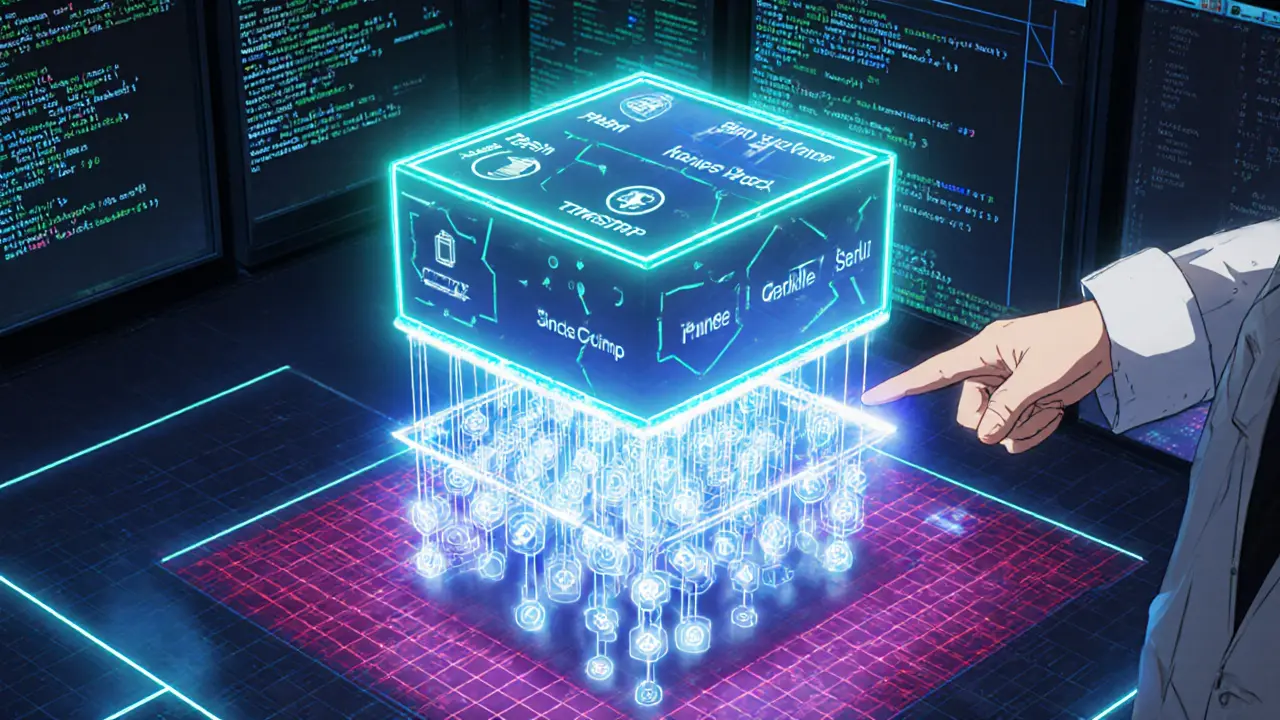Blockchain Block Explorer
Block Information
Explore how a blockchain block is structured and what each component does. Enter values below to customize the block details.
Block Preview
Enter block details and click "Generate Block Preview" to see the structure.
How Blocks Work
Each block contains a cryptographic hash of the previous block, making the chain immutable. This mechanism ensures that once data is recorded, it cannot be altered without detection.
In the world of blockchain, a block is the fundamental unit that makes the chain immutable. Think of it as a digital page in a ledger book - once the page is filled and sealed, it can’t be torn out without ruining the whole book.
TL;DR
- A block stores a set of verified transactions and a cryptographic link to the previous block.
- Key components: header (hash, timestamp, nonce), body (transactions), Merkle root.
- Blocks are added through a consensus algorithm like proof‑of‑work or proof‑of‑stake.
- Immutability comes from each block’s hash containing data from its predecessor.
- Blocks enable transparent, tamper‑proof records but require significant computation.
What Exactly Is a Block?
A block in blockchain is a structured data packet that bundles together a group of validated transactions. Each block carries three essential pieces of information:
- **Header** - contains metadata like the previous block’s hash, a timestamp, and a nonce (the number miners tweak).
- **Body** - the actual list of transactions.
- **Merkle root** - a single hash that summarizes all transactions via a Merkle tree structure.
The very first block, known as the genesis block, sets the foundation for everything that follows. Every subsequent block references the hash of its predecessor, creating an unbreakable chain.
Core Components Explained
Let’s break down the header fields you’ll see in most public blockchains:
- Previous Block Hash - a cryptographic hash of the block before it. Changing any data in the earlier block instantly changes this value, alerting the network.
- Timestamp - records the exact moment the block was sealed, measured in Unix epoch time. This ensures chronological ordering.
- Nonce - a random number that miners adjust to satisfy the difficulty target of the consensus algorithm.
- Merkle Root - the top‑level hash of the Merkle tree, summarizing all transactions in the body.
These fields together give each block its identity, integrity, and place in the sequence.
How Blocks Are Linked Together
The linking mechanism is simple yet powerful: each block’s header stores the hash of the previous block. Because a hash changes dramatically with any tiny alteration, tampering with an old block would break the chain downstream. Imagine a stack of wooden blocks; you can only add to the top without pulling the whole tower down.
When a new block is proposed, every node in the network recomputes the hash chain. If any hash mismatches, the block is rejected. This continuous verification makes the ledger immutable.
Block Creation and Validation Process
Creating a block involves two stages: gathering transactions and achieving consensus.
- Transaction Pool - Nodes collect pending transactions from the mempool, verify signatures, and ensure they meet network rules.
- Consensus - The network runs a consensus algorithm such as proof‑of‑work (PoW) or proof‑of‑stake (PoS). In PoW, miners solve a cryptographic puzzle; the first to find a valid nonce earns the right to add the block and receives a reward.
- Block Broadcast - Once a node creates a valid block, it broadcasts it to peers. Others recompute the hash chain; if everything matches, they append the block to their local copy.
The whole cycle can take seconds (e.g., Bitcoin ~10 minutes, Ethereum ~12 seconds) depending on the network’s difficulty and block time settings.

Advantages Over Traditional Database Records
Why bother with blocks when relational databases already store rows?
- Immutability - Once a block is sealed, it cannot be edited without altering every subsequent block, providing a tamper‑proof audit trail.
- Decentralization - Every participant holds a copy, eliminating a single point of failure.
- Transparency - Anyone can verify the contents by recomputing hashes, fostering trust without a central authority.
These properties are why supply‑chain managers, identity providers, and finance firms are experimenting with blockchain solutions.
Limitations You Should Know
No technology is perfect. Blocks have trade‑offs:
- Latency - Consensus can delay transaction finality, especially in PoW networks.
- Scalability - Storing every block on every node consumes storage and bandwidth; many blockchains cap transaction throughput at a few dozen per second.
- Energy Use - PoW mining consumes large amounts of electricity, raising sustainability concerns.
- Error Handling - Mistakes can’t be deleted; they must be corrected with a new transaction, leaving a permanent record of the error.
Real‑World Applications of Blocks
Blocks aren’t just for cryptocurrencies. Here are a few concrete examples:
- Supply Chain Tracking - Each block logs a product’s hand‑off, giving end‑users verifiable provenance.
- Digital Identity - A block can store a hash of identity credentials, enabling self‑sovereign ID systems.
- Voting Systems - Votes are recorded in blocks, ensuring every ballot is immutable and auditable.
- Medical Records - Sensitive health data can be referenced via a block hash, allowing secure sharing without exposing raw data.
Future Trends: Making Blocks Faster and Greener
Researchers are tackling block limitations with two main strategies:
- Layer‑2 Scaling - Solutions like rollups bundle many transactions off‑chain and settle a single summary block on the main chain, boosting throughput.
- Energy‑Friendly Consensus - Proof‑of‑stake, proof‑of‑authority, and newer hybrid models drastically cut power usage while preserving security.
As these innovations mature, blocks will keep their core security guarantees while becoming more practical for high‑volume use cases.
| Field | Purpose | Example (Bitcoin) |
|---|---|---|
| Previous Block Hash | Links to the preceding block | 0000000000000000000b4c0a… |
| Timestamp | Records when the block was sealed | 1622548800 (Unix epoch) |
| Nonce | Variable used to satisfy PoW difficulty | 2083236893 |
| Merkle Root | Summarizes all transaction hashes | 4b1e...f2e8 |
| Transaction Count | Number of transactions in the block | 2,500 |
Quick Checklist: Evaluating a Block’s Health
- Verify the previous hash matches the actual hash of the prior block.
- Confirm the timestamp is within acceptable drift (usually ±2 hours).
- Re‑calculate the Merkle root from the transaction list and compare.
- Check that the nonce satisfies the network’s difficulty target.
- Ensure all transactions pass signature verification and do not double‑spend.
Frequently Asked Questions
What makes a block immutable?
Immutability comes from each block’s cryptographic hash containing data from the previous block. Changing any detail rewrites the hash, breaking the chain and instantly flagging tampering.
How big can a block be?
Block size limits vary by network. Bitcoin caps blocks at 1MB, Ethereum’s block gas limit translates to roughly 30KB of transaction data, while newer chains like Solana allow several MB per block.
Why do blockchains use Merkle trees?
Merkle trees let a node verify a single transaction’s inclusion by checking a short hash path, instead of scanning every transaction. This saves bandwidth and speeds up validation.
Can a block be edited after it’s added?
Not directly. To alter a block you’d need to redo the proof‑of‑work for that block and every block after it, which is computationally infeasible in a well‑secured network.
What’s the difference between a block and a transaction?
A transaction records a single transfer of value or data. A block groups many such transactions together and adds metadata that links it to the rest of the chain.









Comments (18)
Marie-Pier Horth
October 3, 2025 AT 17:30 PMWhen we stare at the blocks of a blockchain, we are really gazing into the very bones of digital trust. Each block, like a stone in an ancient cathedral, carries the weight of everything that came before it. The header, with its previous hash, timestamp, and nonce, is the solemn inscription that binds the stone to its neighbor. The body cradles the transactions, each a tiny promise of value or data exchange. The Merkle root stands as the altar, summing up all these promises into a single, glowing glyph. The immutability of the chain is not a myth; it is a mathematical guarantee forged by cryptographic hash functions. Changing a single transaction would ripple through the hash, breaking the communion of the chain. Miners, those modern alchemists, expend energy to find the nonce that satisfies the difficulty, a ritual that secures the ledger. Proof‑of‑work, though costly, ensures that no single entity can rewrite history without overwhelming force. Proof‑of‑stake, a newer creed, asks validators to stake their wealth, promising honesty in exchange for reward. The genesis block is the prologue, hard‑coded, setting the tone for every chapter that follows. As new blocks are appended, the network collectively re‑verifies the chain, a chorus of nodes chanting consensus. This decentralized chorus eliminates the need for a central gatekeeper, dispersing power across the participants. Yet the system is not without its shadows: latency, energy consumption, and scalability concerns linger like fog over a mountain. Researchers are building layer‑2 solutions, rolling up transactions off‑chain to lift the burden from the main chain. In the end, a blockchain block is both a container of data and a sentinel of integrity, a paradox that fuels the future of trust.
Gregg Woodhouse
October 7, 2025 AT 21:30 PMi dunno why ppl keep hypin this block stuff its just a bunch of numbers lol
still kinda cool tho lol
F Yong
October 12, 2025 AT 01:30 AMAh, the blockchain mythos-another grand illusion stitched together by the elite to keep us complacent. Of course, every block is said to be immutable, but have you considered who actually controls the hash power? The so‑called "decentralization" is just a front for the hidden cabal of miners. Every timestamp, every nonce, is merely a breadcrumb for those in the shadows to track our transactions. And the Merkle tree? Just a fancy way to compress data so they can hide more than they reveal. Sure, they brag about transparency, yet the real ledger is probably stored elsewhere, behind encrypted walls. So enjoy the illusion of security while the puppeteers pull the strings.
Sara Jane Breault
October 16, 2025 AT 05:30 AMGreat rundown!
Just remember to keep your node updated and check the block hash regularly. It helps keep everything running smooth.
Anurag Sinha
October 20, 2025 AT 09:30 AMListen up folks! The block chain is a massive conspired design! Every hash is pre‑programmed by a hidden elite, I tell ya! The nonce you think miners spend hours on? It’s just a placebo to keep you busy. The timestamps? Synced to a secret server. The Merkle root? A veil to hide the true transaction list. And don’t get me started on the energy usage-it's a smokescreen for something bigger! Stay alert; the network is watching us, every block is a spy node. K new?
Raj Dixit
October 24, 2025 AT 13:30 PMWe must protect our nation’s data integrity, and nothing beats a strong blockchain built by our own people. The proof‑of‑work model showcases our determination and work ethic. Anyone who doubts the power of this technology is simply ignorant of true patriotism.
Nilesh Parghi
October 28, 2025 AT 16:30 PMConsider the block as a tiny universe of trust. Its header encodes the past, while the body carries the present transactions. The Merkle root elegantly summarizes all that lies within, allowing quick verification without scanning each item. This structure underpins the entire chain’s resilience.
Adeoye Emmanuel
November 1, 2025 AT 20:30 PMFascinating explanation! I’m curious about how the difficulty adjustment works over time-does it adapt to network hash power fluctuations? Also, could you elaborate on how layer‑2 solutions interact with the base block’s Merkle root?
Rahul Dixit
November 6, 2025 AT 00:30 AMAnother typical blockchain brag, nothing new. They keep pushing the same tired narrative while ignoring the massive waste. The energy consumption is a scandal, and the centralization of mining pools proves it’s not truly free.
CJ Williams
November 10, 2025 AT 04:30 AMAwesome summary! 🚀
Keep digging into the block structure-you’ll find the Merkle root is like a secret handshake for transactions. 🌟
Stay motivated and keep learning! 💪
mukund gakhreja
November 14, 2025 AT 08:30 AMWow, what a helpful post-truly groundbreaking. I mean, who would have thought that linking hashes could make something immutable? Groundbreaking stuff.
Michael Ross
November 18, 2025 AT 12:30 PMThank you for the clear explanation. It’s helpful to see the components broken down.
Deepak Chauhan
November 22, 2025 AT 16:30 PMEsteemed colleagues, the intricate dance of nonce selection within proof‑of‑work showcases the pinnacle of cryptographic elegance, yet it remains a humble servant to the grand design of decentralized trust.
Henry Mitchell IV
November 26, 2025 AT 20:30 PMNice post.
Kamva Ndamase
December 1, 2025 AT 00:30 AMHoly moly! This dive into block anatomy is like opening a treasure chest of digital wizardry! Each hash is a rune, each nonce a spell-pure magic!
Marie Salcedo
December 5, 2025 AT 04:30 AMGreat job! This breakdown makes blockchain feel a lot less intimidating. Thanks for sharing!
Lana Idalia
December 9, 2025 AT 08:30 AMOh, you think you’re the blockchain guru now? Let me tell you, anyone can spout these buzzwords without really understanding the underlying entropy. Reality check: most users just copy‑paste these fluff pieces without a clue.
Narender Kumar
December 13, 2025 AT 12:30 PMBehold, the majestic block shall forever stand as a monument to human ingenuity, its cryptographic seal unbreakable, its ledger eternal.